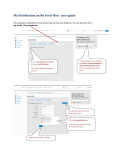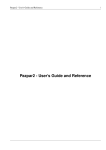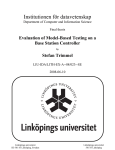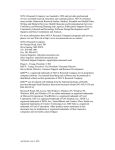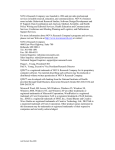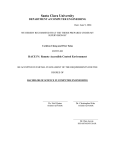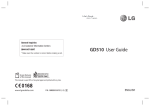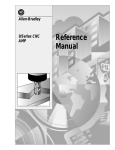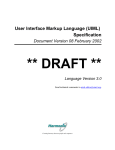Download MUNITY 1 Introduction
Transcript
MUNITY
H. Peter Gumm
Abstract
MUNITY is a program verication system for parallel programs expressed in the UNITY language of K.M.Chandy and J.Misra 1]. Given a
program and a list of hypothesized properties expressed in the temporal
UNITY logic, MUNITY generates and largely proves a list of verication
conditions. The development environment supports the interactive discovery and proof of relevant UNITY properties expressing stability and
progress and, if appropriate, also points to bugs in the specication of
the parallel program. Dealing with data types abstractly we show how
data type requirements can be easily discovered by the system.
1
Introduction
UNITY is a theory for specifying and verifying parallel programs. It consists
of a simple programming language together with a temporal logic style program logic and a proof system. UNITY programs are specied independent
of architectural concerns as a set of nondeterministically executable actions.
Mapping a UNITY program to a particular parallel architecture is considered
separately. The UNITY logic is based on the temporal connectives unless and
ensures. Other temporal operators such as stable, until and leadsTo are derived
from these two connectives. Hoare triples fPg s fQg tie the operational semantics to the programming logic. The temporal properties are dened using
quantication over all assignments s in a UNITY program of Hoare triples
fPg s fQg .
MUNITY is a program verication system based on the UNITY calculus.
Its purpose is to semiautomatically prove that a given UNITY program will
satisfy certain relevant temporal properties. More than just checking truth or
falsehood, we expect that the system is designed to interactively guide the user
to the discovery of relevant program properties and their proofs.
We will start with a brief introduction to UNITY and refer the reader to
the original book by K. M. Chandy and J. Misra 1] for a detailed exposition.
SIEMENS AG., ZFE IS INF 2, Otto Hahn Ring 6, 8000 Munchen 83, Germany and
Fachgebiet Informatik, Philipps Universitat, 3550 Marburg
1
1.1 UNITY programs and their semantics
The basic actions of UNITY are expressed using enumerated assignments. In
its simplest form, an enumerated assignment is just a multiple assignment of a
list of terms to a corresponding list of variables. In general, the right hand side
of the multiple assignment may consist of several guards, each one guarding
its own list of terms, so that an enumerated assignment has the general form
<EnumAssign> ::=
<variableList> :=
<termList> IF <guard> ]
'~' <termList> IF <guard> ]*
]
If more than one guard is true, then all the corresponding term lists are required
to yield the same list of values.
Assignment statements are constructed as parallel compositions
A1 k : : : k A
n
of assignments A . Such compositions can be expressed more generally using
quantication over a tuple of variables satisfying a Boolean expression
i
hk i :::i
1
n
: < boolExpr > :: A 1
i :::i
n
i
A UNITY program is a set of assignment statements. These statements
are connected using the nondeterministic choice operator \]". Again there is a
quantied version, called a quantied statement list :
h]i : : : i
1
n
: < boolExpr > :: A 1
n
i :::i
i
A UNITY program has up to four sections. In a declare-section variables
and their types are declared, in an always section variables are dened as a
function of other variables. These dened variables cannot be assigned to and
are best compared to macros. Initial conditions are declared in the initiallysection and nally the assign-section, consisting of a set of UNITY assignments
represents the executable part of a UNITY program.
The semantics of a UNITY program species that starting from a state
where the condition given in the initially-section is true, statements are then
repeatedly selected from the assign-section nondeterministically and executed.
For the nondeterministic selection a simple fairness condition is assumed: Each
statement is selected innitely often. 1
A UNITY program never terminates, although it may reach a xed point.
A xed point is a state which remains unchanged for every statement. A logical
description of a xed point can be easily derived from the source code using
the following idea : Each assignment x := t IF b contributes the condition b
It is entirely possible that in a conditional statement `x
happens to be false each time the statement is selected.
1
2
:= t IF b'
the condition
b
. The xed point FP is then characterized by the conjunction of all
these conditions.
Although the expressive power of UNITY seems to be somewhat weak at
rst glance, the ability to treat arbitrary data structures on the right hand
side of an assignment statement permits one to hide complicated calculations
that are not relevant in the interplay with other components. Furthermore, the
virtual absence of any control at the statement level gives the implementor sufcient freedom when mapping a UNITY program to a particular architecture.
The following example shows a UNITY specication of a \Faulty Channel"
which may lose or duplicate data, but which will not transmit incorrect data.
For the implementation we use two queues, inQ and outQ with operations
IsEmptyQ, head, tail, and enQ, the latter being written as inx \".
==> x=t
Program faultyChannel
declare
inQ, outQ : queue of data
assign
inQ, outQ := tail(inQ), (outQhead(inQ))
IF not IsEmpty(inQ)
%
] inQ
:= tail(inQ)
IF not IsEmpty(inQ)
%
] outQ := (outQhead(inQ))
IF not IsEmpty(inQ)
%
end
correct transfer
data loss
data duplication
1.2 Program structuring
Structuring of UNITY programs is achieved by decomposing the problem into
logical units, implementing each unit as a UNITY program, then expressing the
nal solution as a union of these smaller programs. A program for the \alternating bit protocol", for instance, could be decomposed into modules representing
\sender", \receiver" and two instances of a (parameterized) \faultyChannel" :
Program altBit =
sender
] receiver
] faultyChannel(sendChannel)
] faultyChannel(ackChannel)
1.3 The UNITY logic
Properties of UNITY programs can be formulated in a temporal logic language
powerful enough to express the relevant aspects of parallel program behavior,
such as safety and progress. Although UNITY programs never terminate, we
can still express termination of a particular algorithm as a progress condition:
3
A program terminates i eventually it reaches a state satisfying the xed point
condition.
The most basic logical connectives used in MUNITY are called unless and
ensures. Both are dened using a quantication over Hoare triples where the
quantication extends over all statements s in the assign section A of the program. For predicates P and Q dene
P
unless Q
$ 8s 2 A : fP ^ :QgsfP _ Qg
Intuitively, if P is true in some state then it will remain true unless Q is or
becomes true. The denition of Hoare triples fPg s fQg is standard, see e.g.
2]. If s is a multiple assignment of the form x1 : : : xn := t1 : : : tn if b then
fPg s fQg translates into the verication condition
(P ^ b ) Qx1 : : : x =t1 : : : t ]) ^ (P ^ :b ) Q):
n
n
This is easily extended to multiple assignments with several guards and to their
parallel composition, i.e. to arbitrary assignment-statements.
The ensures connective requires that there exists at least one statement in
A guaranteeing progress from P to Q, and that no other statement can prevent
this progress :
P
ensures Q
$ (P unless Q) ^ (9s 2 U : fP ^ :QgsfQg)
At the user level there are two operators that are most important to formulate properties of UNITY specications : invariant, to express safety and
leadsTo (denoted by 7!), to express progress. If I is the initial condition then
invariant P
$ (I ) P ) ^ stable P:
The 7! relation is dened as the smallest transitive relation containing the
ensures relation and closed under the disjunction law :
h8m : m 2 W :: P (m) 7! Qi
h9m : m 2 W :: P (m)i 7! Q
that is, if P (m) leadsTo Q individually for each m 2 W then we are allowed
to conclude that the disjunction of all P (m) leadsTo Q. This law allows us
to prove progress conditions by (possibly innite) case analyses. Interestingly,
the nite version of the disjunction law, i.e.
P1 7! Q P2 7! Q
P1 _ P2 7! Q
is already true for the transitive closure of the ensures relation.
4
2
MUNITY
MUNITY is a verication system for UNITY programs that we have created at
the Munich research center of Siemens AG. MUNITY provides a comfortable
program development environment, together with an integrated program verier and theorem prover. The user species a program together with external
safety and progress conditions formulated in the UNITY logic. The system
will formally verify that these conditions are indeed true in the given program.
MUNITY supports the incremental development of a UNITY program satisfying given logical properties, or, given a program, the development of proofs
for basic UNITY properties. The latter capability has been demonstrated in a
case study where we investigated safety and progress properties in a program
controlling magnetic levitation trains 3].
2.1 MUNITY specications
The syntax of a MUNITY program is slightly simpler than the original UNITY
syntax. Mainly, parallel composition of assignments has been removed. Since
we still have multiple assignments, parallel composition is just extra syntactic
sugaring. Also, when inconsistencies between a program and its proposed
properties are detected, parallel composition makes it rather dicult for the
user to pinpoint an exact source of the problem. In all example programs we
have dealt with, equivalent reformulation of parallel composition in terms of
multiple assignments has not seriously aected readability.
A MUNITY specication consists of a program name, an initially-section,
an assign-section and an invariant section. The initially-section, True by default, contains a boolean condition that is assumed to hold at the start of
execution of the program.
The assign-section consists of a set of multiple guarded simultaneous assignments, separated by the \]"-symbol. In an optional invariant-section an
external invariant for the program may be specied. The concepts of internal
and external invariants will be explained later. The full syntax of a MUNITY
specication is :
<MUNITY-spec> ::= program <id>
initially
assign
invariant
end
<boolExpr>
]
<statements>
<boolExpr>
]
<statements> ::= statement ] statement ]*
<statement>
::= <multiple guarded simultaneous assignment>
5
2.2 MUNITY scripts
Along with a MUNITY program we usually want to specify properties of the
program, using connectives from UNITY logic, such as invariant, leadsTo,
unless, ensures, etc. Such properties can be added to the MUNITY specication in a properties section. The combination of a MUNITY program and a
properties-section is called a script.
In the current version, MUNITY can handle the following types of properties: stable, invariant, unless, ensures. LeadsTo formulas can only be formally
veried if they are presented as a transitive chain of ensures formulas. Since
\leadsTo" is dened by inference rules, full support for the verication of arbitrary temporal logic formulas will only be provided by a proof checker for
UNITY logic, whose implementation is in progress.
2.3 External Invariants and the substitution rule
If Q is a property true in every reachable state of program U then Q may
implicitly be used as an assumption whenever we reason about program U .
This is the substance of the substitution rule of 1]. A problem arises, however,
when we combine programs U1 and U2. Properties true in both components
need not remain true in the combination. As an example consider the following
two programs:
Program U1
initially
x=y=0
assign
x := x+1
end
Program U2
initially
x=y=0
assign
y := y+1
end
For the rst program we nd invariant y = 0, so the substitution rule of
1] allows to infer invariant x = 0 _ y = 0 even though x = 0 _ y = 0 is not
stable in U1. We obtain the same invariant for U2, but clearly x = 0 _ y = 0
will not remain true in U1]U2.
Rather than dropping the substitution rule altogether, we introduce the
concept of an external invariant. This must be a property stable in all component programs and initially true in their composition. The external invariant
is the only property which we ever allow to be used as an implicit axiom, i.e.
substituting true. As seen from each component program, its external invariant is both a promise to and an expectation of the environment. In essence
then a UNITY program becomes a pair (U I ) and two programs (U1 I1) and
(U2 I2) can only be composed if I1 = I2. The aim must therefore be, to nd
one external invariant that is as strong as possible, yet still is stable in all
components. In the above example not more than x 0 ^ y 0 could be used
as an external invariant, if the programs are to be combined.
6
The problem with the original substitution axiom in 1] has been noticed
before in the literature. Sanders 4], in fact, has reworked part of the UNITY
calculus using UNITY programs indexed with invariants and thus removed an
unsoundness of the original calculus.
2.4 Verication conditions
Given a MUNITY script, the verier has to check correctness of the MUNITY
specication, and of the MUNITY properties. Correctness of the specication
involves the verication that the proposed external invariant is indeed an invariant of the program part, that consists of the initially- and the assign-sections.
Correctness of the MUNITY-properties means that, assuming the external invariant, the claimed properties are true in the UNITY program. The command
\inv" checks the external invariant and the command \prove" proves the proposed properties. In either case a syntactical check will be made and errors
will be indicated by a message and by a cursor being placed at the oending
position in the source code.
When checking invariants or other properties, MUNITY reduces them to
their denitions via Hoare triples and generates a corresponding series of implications of rst order predicate logic, so called verication conditions. One
after another they are displayed on the screen and the internal rewrite system
attempts a proof. In case a proof does not fully succeed the verication condition is reduced to an equivalent but simpler one and displayed under the
header - Remains to prove - !. The MUNITY script has been veried if
all arising verication conditions have been either proven, or the parts that
``remain to prove'' have been accepted as tautologies by the user.
All verication conditions which the system cannot prove by itself, are simplied and collected in a le axioms.log. They can later be passed to a
general rst order theorem prover. It is important that during proof development the user can concentrate on the design and properties at the UNITY
level, without being required to ll in the often tedious details of proofs for predicate logic tautologies, which many times are obvious to humans. Once the
development phase is completed, of course, the nal MUNITY script cannot
be considered formally veried until all propositions from the axioms.log-le
have been formally veried, using any rst order theorem prover.
2.5 Environment and user interface
Currently there are two MUNITY versions available that dier only in the user
interface, but not in functionality: a command line version running on SUN
workstations and a fullscreen version running on IBM compatible PC's. The
latter version is embedded in an integrated development environment, quite similar to commercial language implementations, such as, e.g. Turbo-Pascal. In a
main editor window the MUNITY-script can be edited and from a menu bar
commands such as \Inv", \Prove", \Files", \Options", \Help" can be chosen.
7
Some commands in turn result in pulldown menus oering more detailed choices
according to context. Syntax errors cause the cursor to be placed at the offending spot in the editor window. Verication conditions are displayed in an
output-subwindow that opens above part of the editor window. While stepping
through the verication conditions, the user may switch back and forth between
editor window and output window in order to associate verication conditions
with the place in the source code from where they arise.
The command line version requires only an ASCII terminal, commands are
entered from the keyboard and syntax errors are indicated by displaying several
lines of the source le surrounding the error location and graphically indicating
the exact spot of the error.
The PC version is a standalone executable le created from a C and TurboProlog source code, whereas the SUN version requires a PROLOG runtime
system - currently we use \Sepia" Prolog 5]. The performance of either systems has never been of much concern, since typically parsing, generation of
verication conditions, and proofs or simplications of individual verication
conditions take place in fractions of a second.
3
Interacting with MUNITY
In this section we shall demonstrate with an example how interactive development and proof of a MUNITY-script proceeds. Since the connection between a
UNITY program and its properties is established via Hoare triples, one has to
start out with (a preliminary version of) a UNITY program. Our development
methodology calls for starting out with an abstract version of the program, then
rening it step by step, mainly through a renement of the data structures involved. This methodology follows 1] and was analogously used in describing
a train control system in 3] and recently by A. Scholz in verifying the \Sliding
Window Protocol".
3.1 Example: Sender-receiver communication
The following UNITY implementation of a communication through unsecure
channels is based on the treatment in 1]. To keep the example concise, we shall
not explicitly implement faulty channels, rather we have sender and receiver
behave in a way that the same message may be sent, received and acknowledged
arbitrarily often. Send- and receive-channels are simply modelled by shared
variables.
In this rst level of abstraction we consider only the ordinal numbers of messages, not their content. Thus the sender sends the sequence of natural numbers
and the receiver uses the last number received for an acknowledgement.
program altBit1
{declare
x,
-- send-channel (sender writes, receiver reads)
8
y,
ks,
kr
-- receive channel (receiver writes, sender reads)
-- number to transmit
-- last received number
: integer }
initially
x=1 and y = 0 and ks = 1 and kr = 0
assign
ks := y+1
% (1) prepare next message
] x := ks
% (2) send message (again)
] kr := x
% (3) receive message (again)
] y := kr
% (4) acknowledge message (again)
end
The most important safety and progress conditions will have to state that
a message (number) received must have been sent
every number is eventually received (hence has been sent)
In UNITY logic we can express them as
invariant kr ks
kr = N 7! kr = N+1
As a MUNITY convention, identiers starting with upper case letters denote
constants, so any write access is prevented by the parser. Constants occurring
within MUNITY properties are implicitly universally quantied. In particular,
the second property must be read as
8N : kr = N 7! kr = N + 1
.
3.1.1 Safety
Starting with the safety condition, we add the proposed invariant
invariant kr <= ks
We would like to use it as an external invariant, since we suspect that this
condition will be needed to prove the proposed progress condition. The verier
now generates a series of verication conditions of which there are two (caused
by program statements 1 and 3) that it cannot prove:
kr<=ks ==> kr<=y+1
and kr<=ks
==> x<=ks
Verication conditions are purely logical statements, so identiers occurring in verication conditions denote logical variables. Hence the actual proof
obligations are :
9
8kr ks y : kr ks ) kr y + 1 and 8kr ks x : kr ks ) x ks.
Since none of these are true, our proposed invariant is not really invariant.
Although true in every program state it does not have the self-perpetuating
property required of an invariant. Since the verication conditions arise from
statements no. 1 and 3, the reason is easily found in the program source:
statement 1 changes ks without regard to kr and similarly, statement 3 changes
kr without regard to ks. Obviously, we have to strengthen the invariant to
somehow also involve x and y. From the previous trials we can read o the
conditions kr <= ks and kr <= y+1 and x <= ks. Still this turns out not
to be an invariant and from the verication conditions that remain to prove
we are soon led to
y <= kr <= x <= ks <= y+1.
kr <= ks
More than just stating
the new invariant guarantees that the
values of kr and ks never dier by more than 1, a crucial property, indeed.
The forced strengthening of the invariant is in complete analogy to what
can be experienced in inductive proofs when the inductive hypothesis needs
to be strengthened in order to prove some weaker property, or what happens
during the proof of a sequential program when the loop invariant needs to be
strengthened even though a weaker consequence is required at the loop's exit.
Finding a \good" invariant is always the rst and often the most dicult
step in proving a UNITY program. The invariant shrinks the space of states
to consider, or, viewed dierently, provides an extra axiom for further proofs.
3.1.2 Progress
Recalling that 7! contains the transitive hull of ensures, we show that
kr
= N 7! kr = N + 1
using a chain of ensures-steps. Such a chain is best discovered by moving
backwards from the desired nal state.
There are two degrees of freedom here: Since we must achieve a chain
kr
= N P0 ensures P1 ::: P ;1 ensures P
n
n
kr = N + 1
we have to nd a proper predicate logical statement P ;1 and further, since
every ensures step involves an existential quantication over all statements s
in the program, we must nd an appropriate s. The latter question is solved
most easily: If proper progress is made towards kr=N+1, then it can only be
through a statement that modies kr, in this case only statement 3 qualies.
MUNITY allows us to annotate ensures conditions with the number of the
statement that in the user's opinion will make the progress.
Next, an appropriate P ;1 is required. It must be some predicate depending
at most on the variables contained in the program, so we formulate the property
n
n
( )
P x y kr ks ensures
10
<3>
kr
= N+1
Of the ve generated verication conditions, all but one are proved by the
system. The only one remaining involves the unknown or abstract predicate
P(x,y,kr,ks):
P(x,y,kr,ks) AND kr<>N+1
AND y<=kr AND kr<=x AND x <= ks AND ks <= y+1
==>
x=N+1
Since none of the premises allows us to conclude much about the proposed
conclusion, the only valid information could be in P(x,y,kr,ks). Since we are
still free to choose, we simply put
P ;1 P(x y kr ks) x = N + 1:
n
The fresh attempt to prove x=N+1
cation condition unproven :
ensures<3> kr=N+1
leaves only one veri-
kr<>N+1
AND y<=kr AND kr<=N+1 AND N+1<=ks AND ks<=y+1
==>
ks=N+1 OR kr=N+1
As before, we see how the external invariant appears as an additional axiom in
every verication condition. The current one, is indeed a tautology provided
that all identiers denote integers, so in this case the rst ensures condition has
been proven. We may also interpret it in a dierent way :
Since we declined to declare variables, this verication condition introduces
a data structure constraint for the common type T of x,y,ks, and kr:
8p q 2 T : p q p + 1 =) (q = p) _ (q = p + 1):
After thus establishing P ; x = N + 1 we keep working backwards until
n
1
we have produced the ensures chain
kr=N ensures N=y ensures ks=N+1 ensures x=N+1 ensures kr=N+1,
witnessing kr=N 7! kr=N+1. In each case a verication condition quite similar
to the last one remains, but no new constraints are introduced.
3.2 Inferring data structures
In the next version the sender sends from an innite sequence ms of messages.
Again, ks is the count of the current message to be transmitted. The message
itself is msks]. The send-channel now has two components, index and value
which we name x.dex and x.val. Again we acknowledge with the ordinal number of the last message received. The messages are stored by the receiver in a
11
queue mr. It is not necessary to have specic data types available to implement
the queue operations. We simply invent appropriate names for the operations
such as enQ or firstQ, etc. and we are prepared to assume appropriate axioms. Since all UNITY actions must be expressed as assignments, we denote
an enqueuing of a new data item x into queue mr by mr := enQ(mr,x). Our
program renes to :
Program altBit2
initially
x.dex = 1 and y = 0 and ks = 1 and kr = 0 and
mr = Null and x.val = ms1]
assign
y
:= kr
]
ks
:= y+1
]
x.dex,x.val := ks,msks]
]
kr,mr
:= x.dex, enQ(mr,x.val)
if kr <> x.dex
invariant
y <= kr and kr <= x.dex and x.dex <= ks and ks <= y+1
end
The external invariant essentially remains, but at rst glance it is not clear how
to express safety and progress conditions, since our syntax only allows open
formulas inside the MUNITY-properties. The safety property must express
that what has been received has also been sent. Let us call this relation Prefix.
Specifying the invariant
invariant Prefix(mr,ms)
we obtain a verication condition
Prefix(mr,ms) AND y<=kr AND ... ==> Prefix(enQ(mr,x.val),ms)
where the "..." represent the external invariant. Since x.val does not occur
anywhere in the premise, we must establish some relationships between the
variables involved. If x.val was just enqueued, we should expect that it was
the last message sent, so it ought to have been read o the array ms at place
ks, so the new invariant becomes :
Prefix(mr,ms) AND msx.dex]=x.val.
This produces a verication condition
Prefix(mr,ms) AND msx.dex]=x.val AND ...
==>
Prefix(enQ(mr,x.val),ms)
Hence it becomes clear that we must relate x.dex to the length of mr, so nally
we arrive at the invariant:
12
Prefix(mr,ms) and x.val=msx.dex] AND kr=length(mr).
Since this is the rst time that MUNITY ever encounters \length" and \Prex", we are nished, if all verication conditions can be proven using only
such axioms about \Prex" and \length" that we are willing to assume about
these notions, i.e. axioms that are logically consistent. Indeed the following
verication is generated:
Prefix(mr,ms)
AND msx.dex]=x.val
AND kr=length(mr)
AND kr <> x.dex
AND y <= kr <= x.dex <= ks <= y+1
==>
Prefix(enQ(mr,msx.dex]),ms)
AND x.dex=length(enQ(mr,msx.dex])
The hypothesis implies that x.dex=length(mr)+1, so the following two axioms
are needed about Prefix and length :
For all queues q and all arrays s :
length(Null)=0
length(enQ(q,x)) = length(q)+1
Prefix(Null,s)
Prefix(enQ(q,slength(q)+1]),s)
Assuming these axioms about Prefix, Null, and enQ we have shown that
the queue of messages received is always a prex of the sequence of messages
to be sent, and additionally we have interactively inferred the necessary data
structure axioms from the program. We get by without using quantiers in
our specication. The function length in fact plays an auxiliary role as a
Skolem-function. A progress property is now easily formulated as
( ) = N 7! length(mr) = N + 1
length mr
Its proof proceeds via the following ensures-chain:
length(mr)=N
ensures<1> length(mr)=N and kr <> y+1
ensures<3> length(mr)=N and kr <> x.dex
ensures<4> length(mr)=N+1
In the nal version which, due to space limitations, will not be discussed
here, only one bit, ks mod 2, is added to the message sent and only one bit,
kr mod 2 is acknowledged. It is not hard to adapt the invariant accordingly in
order to prove the same safety and progress properties as before.
13
4
Conclusion
We have described MUNITY, an interactive verier for UNITY programs and
we have demonstrated with an example how such a tool can guide the user to
relevant properties of concurrent programs. Proof attempts lead to rst order
properties from which axioms for the required data types can be inferred.
References
1] K. M. Chandy, J. Misra Parallel Program Design. Addison Wesley, 1988.
2] J. W. deBakker Mathematical Theory of Program Correctness Prentice
Hall, Englewood Clis, N. J., 1980.
3] H. P. Gumm Verifying the Transrapid System in Munity. Preprint, 1992.
4] B. Sanders Eliminating the Substitution Axiom from UNITY Logic.
Formal Aspects of Computing 3(1991), 189-205. Preprint, 1992.
5] Sepia 3.1 User Manual ECRC, 1991.
14














